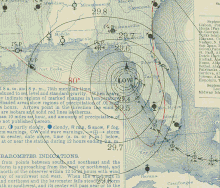
Back Huracà del dia del treball de 1935 Catalan Labor-Day-Hurrikan German Huracán del Día del Trabajo de 1935 Spanish Ouragan de la Fête du travail 1935 French 1935-ös munka ünnepi hurrikán Hungarian 1935년 노동절 허리케인 Korean Furacão do Dia do Trabalho de 1935 Portuguese Ураган Дня труда Russian 1935 Labor Day hurricane SIMPLE Labour Day-orkanen 1935 Swedish
This article has multiple issues. Please help improve it or discuss these issues on the talk page. (Learn how and when to remove these messages)
|
 Weather Bureau surface weather map of the hurricane moving up the west coast of Florida | |
| Meteorological history | |
|---|---|
| Formed | August 29, 1935 |
| Extratropical | September 6, 1935 |
| Dissipated | September 10, 1935 |
| Category 5 major hurricane | |
| 1-minute sustained (SSHWS/NWS) | |
| Highest winds | 185 mph (295 km/h) |
| Lowest pressure | 892 mbar (hPa); 26.34 inHg (Lowest recorded in the United States; third-lowest recorded in the Atlantic) |
| Overall effects | |
| Fatalities | 423 |
| Damage | $100 million (1935 USD) |
| Areas affected | The Bahamas, Florida Keys, Southwest and North Florida (Big Bend), Georgia, The Carolinas, Virginia, Maryland, Delaware, New Jersey, New York, New England |
| IBTrACS | |
Part of the 1935 Atlantic hurricane season | |
The 1935 Labor Day hurricane was an extremely powerful and devastating Atlantic hurricane that struck the southeastern United States in early September 1935. For several decades, it was the most intense Atlantic hurricane on record in terms of barometric pressure until being surpassed by Hurricane Gilbert in 1988;[1] the strongest Atlantic hurricane on record in terms of 1-minute sustained winds (surpassed by Hurricane Allen in 1980); and the strongest at landfall by 1-minute sustained winds (tied with Hurricane Dorian in 2019). The fourth tropical cyclone, third tropical storm, second hurricane, and second major hurricane of the 1935 Atlantic hurricane season, it is one of four Category 5 hurricanes on record to strike the contiguous United States, along with Hurricane Camille (1969), Hurricane Andrew (1992), and Hurricane Michael (2018).
The hurricane intensified rapidly during its time, passing near Long Key on Labor Day evening, September 2. The region was swept by a massive storm surge as the eye passed over the area. The waters quickly receded after carving new channels connecting the bay with the ocean; however, gale-force winds and rough seas persisted into Tuesday, disrupting rescue efforts. The storm continued northwestward along the Florida west coast, weakening before making its second landfall near Cedar Key, Florida, on September 4.
The hurricane caused catastrophic damage in the upper Florida Keys, as a storm surge of approximately 18 to 20 feet (5.5 to 6.1 m) swept over the low-lying islands. The hurricane's strong winds and the surge destroyed nearly all the structures between Tavernier and Marathon. The town of Islamorada was obliterated. Portions of the Key West Extension of the Florida East Coast Railway were severely damaged or destroyed. In addition, many veterans died in work camps created for the construction of the Overseas Highway, in part due to poor working conditions. The hurricane also caused more damage in northwest Florida, Georgia, and the Carolinas.
- ^ Hensen, Bob. "Remembering the Labor Day Hurricane of 1935 in the Florida Keys". Weather Underground. Archived from the original on August 29, 2016. Retrieved August 14, 2016.